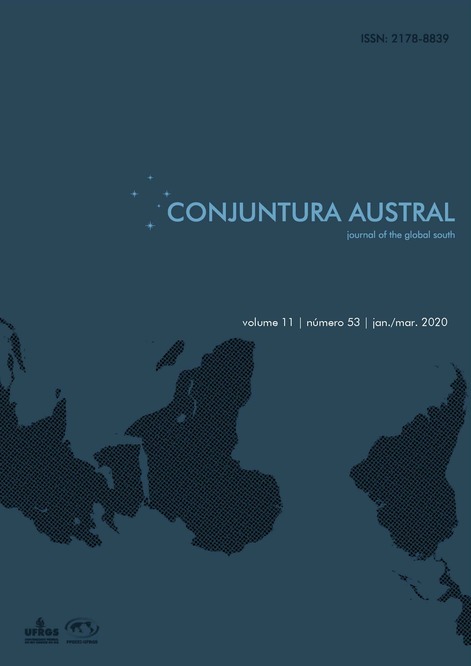Economic rebalancing and geoeconomic challenges for China: the case of intra-BRICS and foreign direct investments
DOI:
https://doi.org/10.22456/2178-8839.97150Keywords:
China, Rebalancing, BRICS, Trade, Foreign Direct InvestmentAbstract
This article investigates a challenge that China will face in the coming years: the geoeconomic consequences of rebalancing its growth regime. On the demand side, Chinese investment and exports give room for consumption, reducing imports of capital goods and increasing imports of consumption goods. On
the production side, manufacturing loses ground to services. Yet, each regime implies different streams of commercial and investment flows, and patterns of influence, cooperation, and partnership. Thus, the spatial distribution of international trade and FDI must change, modifying economic linkages between China and its partners, like BRICS, and their bargaining power in the world economy. This study evaluates the trajectory of Chinese imports of goods and FDIs from other BRICS countries. In terms of trade, we assess the competitiveness of each country’s exports in relation to Chinese output. Regarding FDI flows, we consider the sectoral distribution of investments carried out by the largest Multinational Corporations (MNCs) from BRICS to assess likely changes. Our research suggests that the impacts of rebalancing on each BRICS
country are mostly negative and asymmetrical, depending on the position of the latter in the international division of labor, shaped by the very geoeconomic influence of China.
Downloads
Downloads
Published
How to Cite
Issue
Section
License
Authors who publish with this journal agree to the following terms:
a. Authors retain the copyright and grant the journal the right to first publication, with the work simultaneously licensed under the Creative Commons Attribution-Non Commercial-ShareAlike 4.0 International License, which allows its use, distribution and reproduction in any medium, as well as its transformation and creations from it, as long as the original author and source are credited. Also, the material cannot be used for commercial purposes, and if it is transformed, or used as a basis for other creations, these must be distributed under the same license as the original.
b. Authors are able to enter into separate, additional contractual arrangements for the non-exclusive distribution of the journal's published version of the work (e.g., post it to an institutional repository or publish it in a book), with an acknowledgment of its initial publication in this journal.
c. Authors are allowed to deposit, in the repositories accepted by Conjuntura Austral, the preprint version of the manuscripts submitted to the journal prior to and during the submission process, as it can lead to productive exchanges, as well as earlier and greater citation of published work (See The Effect of Open Access)
d. Authors are permitted and encouraged to publish and distribute online (in institutional and /or thematic repositories, on their personal pages, etc.) the postprint version of the manuscripts (accepted and published), without an embargo period.
e. Conjuntura Austral: Journal of the Global South, imbued with the spirit of ensuring the protection of regional academic and scientific production in Open Access, is a signatory to the Mexico Declaration on the use of the Creative Commons BY-NC-SA license to guarantee the protection of academic and scientific production in open access.








